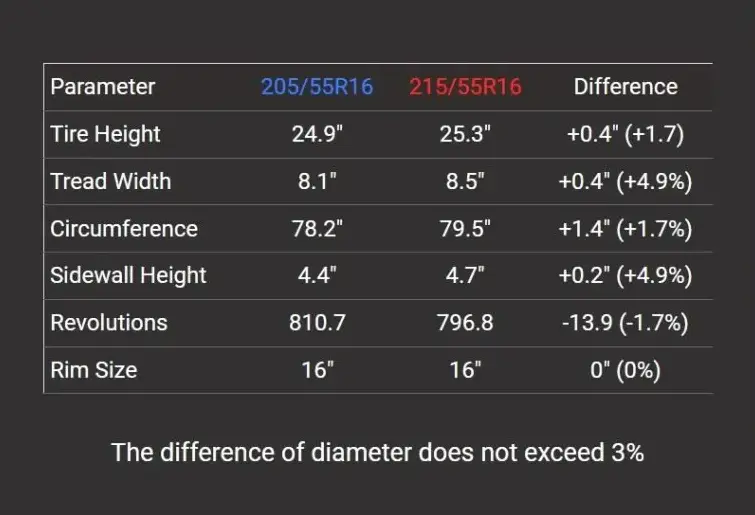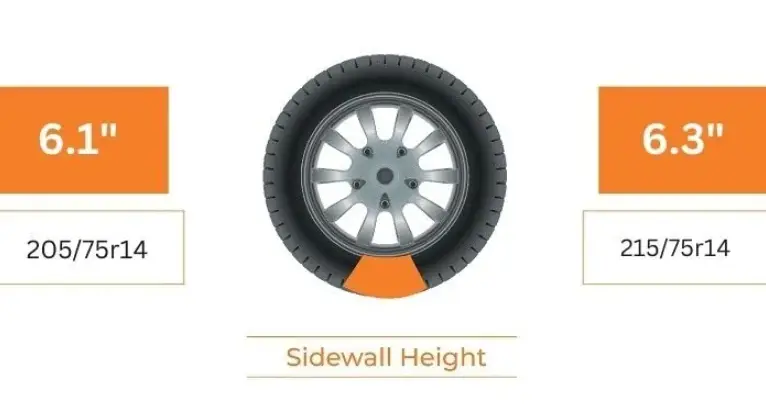The difference between 205 and 215 tires is that 215 tires are 10mm wider, offering better grip and handling, while 205 tires provide better fuel efficiency and a smoother ride.
Choosing the right tire size for the vehicle is important, as it directly impacts the driving experience, fuel efficiency, safety, and overall performance. When it comes to tire size, the numbers 205 and 215 often come up, and many people are unsure about which one to choose. While both tire sizes may appear to be very similar at first glance, there are key differences that can affect everything from grip and handling to fuel economy and comfort.
In this article, we’ll explain the differences between 205 and 215 tires, covering everything you need to know—from their construction and compatibility to performance, fuel efficiency, ride comfort, and more.

Contents
- 1 What Do the Numbers 205 and 215 Mean?
- 2 Performance and Handling: How Tire Width Affects Your Driving Experience
- 3 Fuel Efficiency: How Tire Width Affects Gas Mileage
- 4 Noise Levels: The Difference in Road Noise Between 205 and 215 Tires
- 5 Compatibility: Will 215 Tires Fit on 205 Rims?
- 6 Cost Considerations: Are 215 Tires More Expensive?
- 7 Pros and Cons: 205 vs. 215 Tires
- 8 Frequently Asked Questions
- 9 Conclusion
What Do the Numbers 205 and 215 Mean?
Tire size is denoted by a series of numbers, such as 205/55R16 or 215/60R16, and these numbers provide vital information about the tire’s dimensions. The first number refers to the tire’s width in millimeters, so:
- 205 Tires are 205mm wide.
- 215 Tires are 215mm wide.
While it may seem like a small 10mm difference, that additional width can significantly affect the tire’s performance.
Performance and Handling: How Tire Width Affects Your Driving Experience
The width of a tire has a significant impact on the vehicle’s performance, especially when it comes to handling and cornering. In this section, we will explore how the width difference between 205 and 215 tires influences performance.
Grip and Traction
The most noticeable difference between 205 and 215 tires is the grip and traction. Wider tires like the 215s have a larger contact patch with the road, which leads to improved traction and handling, especially in dry conditions. Wider tires are known to provide more stability when cornering, allowing for a more responsive driving experience.
However, in wet conditions, wider tires may experience hydroplaning more easily due to the larger contact patch, which struggles to channel water effectively. In contrast, the narrower 205 tires tend to perform better in the rain, as they cut through water more efficiently.
Handling and Cornering
Tires with a wider width (215) provide better cornering stability and grip, allowing you to take tight turns with more control. On the other hand, the narrower 205 tires, while offering good handling, may not perform as well during sharp turns at high speeds.
For performance vehicles or sports cars, wider tires like the 215s can improve the overall driving dynamics and provide more traction, especially on dry, smooth roads.
Fuel Efficiency: How Tire Width Affects Gas Mileage
One of the factors that may influence your choice of tire size is fuel efficiency. When you increase the width of the tire, there’s a corresponding increase in rolling resistance.
Rolling Resistance
Wider tires create more resistance between the tire and the road, requiring more energy to rotate. This leads to slightly higher fuel consumption. For example, 215 tires will consume more fuel compared to 205 tires because they require more power to maintain motion.
However, the difference in fuel economy is often minimal, typically not exceeding a few miles per gallon, depending on the driving conditions and tire model.
If you are focused on maximizing fuel efficiency, you may prefer 205 tires due to the lower rolling resistance, leading to less fuel consumption.
Noise Levels: The Difference in Road Noise Between 205 and 215 Tires
Tire width can also affect the level of road noise you experience during driving. In general, wider tires (215) tend to generate more road noise compared to narrower tires (205), as the larger contact patch creates more friction with the road surface.
Ride Comfort
The noise levels also depend on the tire’s tread design and the materials used in the construction. While some 215 tires have specially designed patterns to reduce noise, they still tend to be louder than 205 tires. If a quiet cabin is a priority for you, the 205 tires might be the better choice for a more peaceful ride.
Compatibility: Will 215 Tires Fit on 205 Rims?
You may wonder whether 215 tires can fit on rims designed for 205 tires. The short answer is yes, but it depends on your vehicle’s specifications.
Rim Width and Compatibility
Both 205 and 215 tires can typically fit on the same rims, as the width difference is only 10mm. However, it’s essential to ensure that the rim width and tire specifications are compatible. Check your vehicle’s manual or consult with a professional mechanic to confirm if the change is suitable for your specific model.
Potential Issues
Using 215 tires on rims designed for 205 tires may cause slight changes in handling, and you could experience rubbing if the tires are too wide for the vehicle’s wheel well. Always check your vehicle’s specifications before making this switch.
Cost Considerations: Are 215 Tires More Expensive?
Generally speaking, 215 tires are slightly more expensive than 205 tires due to the additional width and materials used in their construction. However, the price difference is often minimal.
If you’re on a tight budget and need to replace your tires, 205 tires might be the more economical choice. But if you’re after better performance, improved handling, and greater traction, spending a little more on 215 tires could be worth the investment.

Pros and Cons: 205 vs. 215 Tires
Let’s summarize the key advantages and disadvantages of both 205 and 215 tires.
| Feature | 205 Tires | 215 Tires |
|---|---|---|
| Grip | Better in wet conditions | Better in dry conditions |
| Ride Comfort | More comfortable, less road noise | Slightly firmer, noisier |
| Fuel Efficiency | More efficient, lower rolling resistance | Slightly less efficient due to higher rolling resistance |
| Cost | Generally cheaper | Slightly more expensive |
| Performance | Sufficient for regular driving | Enhanced performance, better cornering |
| Compatibility | Easier to fit on most vehicles | Can fit on many vehicles, but check specifications |
Frequently Asked Questions
Here are some FAQs about difference between 205 and 215 tires –
1. Can I replace 205 tires with 215 tires?
Yes, you can replace 205 tires with 215 tires, provided your vehicle’s rims are compatible with the wider size and there are no clearance issues. Always check with a professional before making this change.
2. Will changing to 215 tires affect my vehicle’s speedometer?
Yes, changing to 215 tires can affect the accuracy of your speedometer. Since 215 tires are slightly larger in diameter, they will cause your speedometer to underreport your speed.
3. Are 215 tires better for performance vehicles?
Yes, 215 tires are often a better option for performance vehicles due to their enhanced grip, cornering stability, and traction in dry conditions.
4. Will 215 tires wear out faster than 205 tires?
Tire wear depends on several factors such as driving habits, road conditions, and tire maintenance. Both 205 and 215 tires can last similar durations if properly maintained.
5. Can I use 215 tires on a trailer instead of 205 tires?
Yes, you can use 215 tires on a trailer if they match the required load rating and fit properly within the wheel well. Always verify compatibility before making the switch.
Conclusion
Whether you choose 205 or 215 tires depends on your driving style, budget, and the conditions you typically drive in. If you prioritize fuel efficiency, ride comfort, and a quieter ride, 205 tires might be the better option. On the other hand, if you’re looking for better handling, more grip in dry conditions, and improved performance, 215 tires could be the way to go.